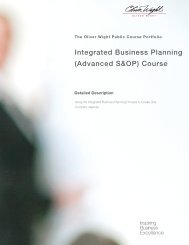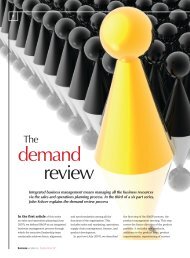Integrated Reconciliation Review - Oliver Wight Americas
Integrated Reconciliation Review - Oliver Wight Americas
Integrated Reconciliation Review - Oliver Wight Americas
Create successful ePaper yourself
Turn your PDF publications into a flip-book with our unique Google optimized e-Paper software.
for the upcoming 24 months.<br />
This financial appraisal will<br />
require an integrated view from<br />
demand, supply and finance. For<br />
example, the average selling price<br />
needs to be forecast for each family<br />
and sub-family over the planning<br />
horizon. This price forecast is<br />
provided as an output of the demand<br />
review, and must take into account<br />
product mix changes, pricing<br />
changes, promotions, etc. Variable<br />
costs, such as material, labor,<br />
and other variables, are forecast<br />
by purchasing, human resources,<br />
and production. This set of cost<br />
projections is provided as part of the<br />
output of the supply review.<br />
Purchasing forecasts the purchase<br />
price changes, by commodity, over the<br />
planning horizon. The cost of resources<br />
and other product management costs<br />
(tooling, etc.) are developed from<br />
the product management review.<br />
Overheads, period costs, and capital<br />
expenditures are forecast as well<br />
as cash flow plans generated from<br />
the operational plans. The financial<br />
data in this step converts the plans<br />
developed in steps one through three<br />
from units to dollars and allows senior<br />
management to better understand<br />
the impact of the plan on the profit<br />
and loss statement of the business.<br />
Once the financial evaluation is<br />
complete, the issues arising from<br />
“To be truly effective,<br />
plans must be converted<br />
to the language of senior<br />
management—revenue,<br />
profit, costs, cash flow,<br />
and so forth”<br />
steps one through three and the<br />
alternative plans developed to<br />
resolve those issues are reviewed.<br />
The plans are evaluated against the<br />
business plan, the strategic plan,<br />
and the performance metrics of the<br />
business. A gap analysis is then<br />
performed where there are shortfalls<br />
to the business and strategic plans<br />
or a performance metric such as<br />
EBITA (earnings before interest, tax<br />
and amortization).<br />
The individuals accountable<br />
for this step discuss the issues<br />
and gaps and create alternative<br />
solutions to resolve these<br />
issues and gaps. The<br />
integration reconciliation<br />
team then develops<br />
recommendations<br />
on<br />
the selection of the<br />
right alternative (or<br />
alternatives if there are<br />
valid scenarios around<br />
the issue or gaps) and<br />
fully costs and evaluates<br />
those alternatives. Once<br />
all the appropriate<br />
information is gathered,<br />
the group prepares the<br />
“S&OP packet” that is<br />
sent, at least 24 hours in<br />
advance, to the attendees<br />
of the management<br />
business review (MBR)<br />
meeting.<br />
There are some<br />
companywide<br />
projects<br />
or initiatives that do<br />
not naturally fit into the<br />
first three S&OP steps<br />
(product, demand, and<br />
supply). These projects are<br />
coordinated through the<br />
integrated reconciliation<br />
step. The integrated<br />
reconciliation team will<br />
communicate the impact<br />
of these projects or<br />
initiatives on common<br />
resources to the other process steps<br />
and recommend priorities for those<br />
projects. The senior management<br />
team will establish the overall<br />
priorities for these projects.<br />
12 Businessexcellence November 07
















